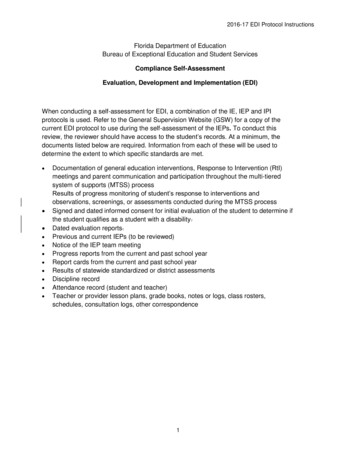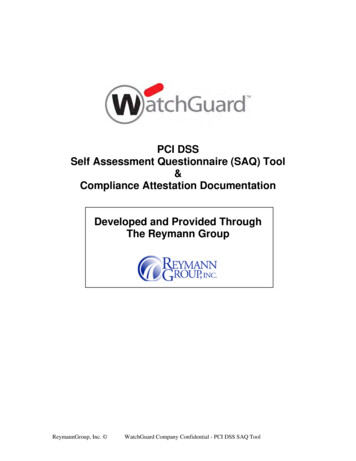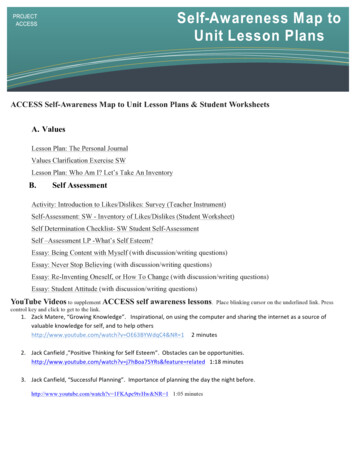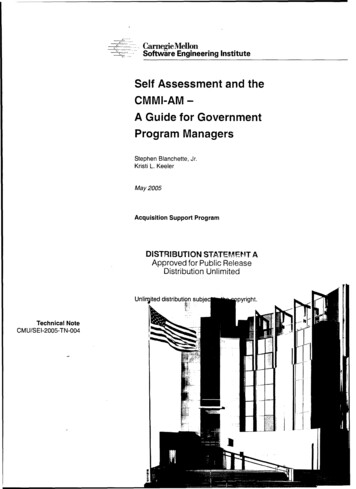
Transcription
2016-17 EDI Protocol InstructionsFlorida Department of EducationBureau of Exceptional Education and Student ServicesCompliance Self-AssessmentEvaluation, Development and Implementation (EDI)When conducting a self-assessment for EDI, a combination of the IE, IEP and IPIprotocols is used. Refer to the General Supervision Website (GSW) for a copy of thecurrent EDI protocol to use during the self-assessment of the IEPs. To conduct thisreview, the reviewer should have access to the student’s records. At a minimum, thedocuments listed below are required. Information from each of these will be used todetermine the extent to which specific standards are met. Documentation of general education interventions, Response to Intervention (RtI)meetings and parent communication and participation throughout the multi-tieredsystem of supports (MTSS) processResults of progress monitoring of student’s response to interventions andobservations, screenings, or assessments conducted during the MTSS processSigned and dated informed consent for initial evaluation of the student to determine ifthe student qualifies as a student with a disability.Dated evaluation reports.Previous and current IEPs (to be reviewed)Notice of the IEP team meetingProgress reports from the current and past school yearReport cards from the current and past school yearResults of statewide standardized or district assessmentsDiscipline recordAttendance record (student and teacher)Teacher or provider lesson plans, grade books, notes or logs, class rosters,schedules, consultation logs, other correspondence1
2016-17 EDI Protocol InstructionsEDI-1 (IE 1).There is documentation of parental involvement in the general educationintervention procedures.(Rule 6A-6.0331(1)(a), F.A.C.)Review documentation of parental involvement and communication during the generaleducation intervention process. Opportunities to be involved in a data-based problemsolving process to address the student’s areas of concern must be made available. Inaddition, there must be discussion with the parent regarding the data used to identifythe problem and monitor student progress, the student’s response to instruction andinterventions, modification of the interventions, when needed, and anticipated futureaction to address the student’s learning or behavioral needs.Mark “yes” if there is documentation of parental involvement in the general educationintervention procedures as described above.Mark “no” if there is insufficient documentation of the required parental involvement.Mark “n/a” for the following exceptions: The child is younger than kindergarten entry age. The student is not enrolled in a public school. The team of qualified professionals and the parent determined that the generaleducation interventions are not appropriate because the student demonstrates aspeech disorder or severe cognitive, physical or sensory disorders or severe socialand behavioral deficits that require immediate, intensive intervention to preventharm to the student or others.EDI-2 (IE 2). Observations of the student must be conducted in the educationalenvironment and, as appropriate, other settings to document the student’sacademic or behavioral areas of concern. At least one observation mustinclude an observation of the student’s performance in the generalclassroom.(Rule 6A-6.0331(1)(b), F.A.C.)Review the student’s record to verify the required observations, including at least oneobservation of the student’s performance in the general classroom.Mark “yes” if there is evidence of the required observations, including at least oneobservation in the general education classroom.Mark “no” if there is insufficient evidence or no evidence of an observation in thegeneral classroom.Mark “n/a” for the following exceptions: The child is younger than kindergarten entry age. The student is not enrolled in a public school. The team of qualified professionals and the parent determines that these generaleducation interventions are not appropriate for a student meeting the criteria inEDI-1 (IE 1).2
2016-17 EDI Protocol InstructionsEDI-3 (IE 5). Evidence-based interventions addressing the identified areas of concern wereimplemented in the general education environment.(Rule 6A-6.0331(1)(e), F.A.C.)Review documentation to determine if evidence-based interventions were developed bya team through a data-based problem-solving process using student performance datato identify and analyze the area(s) of concern, select and implement interventions, andmonitor effectiveness of the interventions. Interventions shall be implemented asdesigned for a period of time sufficient to determine effectiveness, and with a level ofintensity that matches the student’s needs.This requirement may not be necessary for students suspected of having a disability ifthe team of qualified professionals and the parent determine that general educationinterventions are not appropriate and there is documentation justifying this decision.These students may include students with speech disorders or severe cognitive,physical, or sensory disorders. They also may demonstrate severe social/behavioraldeficits that require immediate intervention through special education services toprevent harm to themselves or others.Checklists with initiation and duration dates of interventions would not be consideredsufficient evidence. Evidence should include graphical or other representations ofintervention effectiveness, such as graphs representing pre-intervention and ongoingprogress-monitoring measures of academic and behavioral areas of concern andsummary descriptions of conferences, intervention team meetings, and observations ofthe student.Mark “yes” if there is sufficient documentation that evidence-based interventions weredeveloped by a problem-solving team, implemented as designed in the generaleducation environment, and monitored for effectiveness.Mark “no” if there is not sufficient documentation of the implementation of evidencebased interventions in the general education environment.Mark “n/a” for the following exceptions: The child is younger than kindergarten entry age. The student is not enrolled in a public school. The team of qualified professionals and the parent determines that these generaleducation interventions are not appropriate for a student meeting the criteria inEDI-1 (IE 1).EDI-4 (IE 6). Ongoing progress-monitoring measures of academic and behavioral areas ofconcern were collected and shared with parents in an understandableformat.(Rule 6A-6.0331(1)(e), F.A.C.)Review the student’s record to determine if the data collected identifies and analyzesthe areas of concern. The collected data should also determine the selection and3
2016-17 EDI Protocol Instructionsimplementation and monitor the effectiveness of the interventions. The data shoulddemonstrate that general education interventions were implemented over a reasonableperiod of time sufficient to demonstrate their effectiveness, and with a level of intensitythat matches the student’s needs. Pre-intervention and ongoing progress monitoringmeasures of academic or behavioral areas of concern must be collected andcommunicated to the parents in an understandable format, which may include, but isnot limited to, graphic representation.Mark “yes” if there is sufficient documentation of ongoing progress-monitoringmeasures of academic or behavioral areas of concern and communication with theparent in an understandable format.Mark “no” if there is not sufficient documentation or communication with the parent isnot in an understandable format.Mark “n/a” for the following exceptions: The child is younger than kindergarten entry age. The student is not enrolled in a public school. The team of qualified professionals and the parent determines that these generaleducation interventions are not appropriate for a student meeting the criteria inEDI- 1 (IE 1).EDI-5 (IE 10). The school district requested consent within 30 calendar days of evidenceindicating that the student may be a student with a disability who needsspecial education, or within 30 days of a parent request for an evaluation.(34CFR §300.300(a)(1)(i); Rule 6A-6.0331(3)(a-c), F.A.C.)Parental consent to evaluate must be requested within thirty (30) calendar days of adistrict’s suspicion that the student may be a student with a disability as evidenced byany of the following circumstances:1. The school-based team’s review of K-12 student response to intervention dataindicates that the effectiveness of intensive interventions can only be sustained byproviding a level of intensity and resources beyond general education interventionresources.2. The school-based team’s review of K-12 student response to intervention dataindicates that the student does not make adequate growth given effective coreinstruction and intensive, evidence-based interventions.3. Results of a developmental screening by the Florida Diagnostic and LearningResource Center or the school district, indicate that a prekindergarten child may bea child with a disability who needs special education.OR4. The parent requested an evaluation and there is evidence that the student may bea student with a disability who needs special education.4
2016-17 EDI Protocol InstructionsMark “yes” if the district requested consent within 30 calendar days of anycircumstances identified above.Mark “no” if: The district requested consent beyond 30 calendar days of any of thecircumstances identified above, or The district failed to request consent under any of the circumstances identifiedabove.Mark “n/a” if: The district provided written notice of refusal within 30 calendar days of theparent request to conduct an initial evaluation.The parents and district agreed to a different timeline.The evidence indicating that the student may be a student with a disabilitywho needs special education or the parent’s request for evaluation wasbefore December 23, 2014.EDI-6 (IE 11). The school district obtained informed consent from the parent prior toconducting the initial evaluation.(34 CFR §300.300(a)(1)(i); Rule 6A-6.0331(4)(a), F.A.C.)Compare the dates of parental consent and the administration of the first evaluationprocedure conducted. (Note that screenings and other activities conducted as part ofthe team problem-solving process do not require consent.)For students for whom general education interventions have been implemented:Mark “yes” if the date of the first evaluation procedure was on or after receipt of parentconsent.Mark “no” if the district administered the first evaluation procedure prior to thereceipt of parent consent.Mark “n/a” if neither of the following is true: The parent provided the entire evaluation (i.e., an independent evaluation at parentexpense). The district did not conduct additional assessments or evaluation procedures.EDI-7 (IEP 4). The parents were provided notice of the IEP team meeting a reasonableamount of time prior to the meeting, at least one attempt to invite the parentwas through a written notice, and a second attempt was made if noresponse was received from the first notice. (34 CFR §300.322(a)(1))A second notice is not required if the parents accepted the first notice but did notattend. Documentation may take the form of written notice, records or logs of personalcontacts such as telephone calls and visits to the home or place of employment.A week to 10 days is generally reasonable, although shorter notice would be5
2016-17 EDI Protocol Instructionsconsidered reasonable if the parents were able to attend without undue difficulty. If thenotice was provided a very short time before the meeting (e.g., less than one week),consider whether there were mitigating circumstances (e.g., the parents agreed to orrequested a meeting as soon as possible, the meeting included a manifestationdetermination).If the meeting was held on or after July 1, 2013, and the purpose of the meetingwas the consideration of instruction in access points, administration of alternatestate assessment, or placement in an ESE center school, was the written notice ofthe meeting provided to the parent at least 10 days in advance.Note: Upon receipt of the written notice, the parent may agree to meet prior to the 10thday.Mark “yes” if there is evidence of all the following: At least one written notice was provided. The written notice was provided a reasonable amount of time before the meeting,and at least 10 days prior to meetings considering alternate state assessment,access points instruction, or placement in an ESE center school. If the parent failed to respond to the first attempt, a second attempt was madeto invite the parents.Mark “no” if there is no evidence of one or more of the above.EDI-8 (IEP 12). The IEP for a school-age student includes a statement of present levels ofacademic achievement and functional performance related to the servicesto be provided, including how the student’s disability affects involvementand progress in the general education curriculum. For a prekindergartenstudent, the IEP contains a statement of how the disability affects thestudent’s participation in appropriate activities.(34 CFR §300.320(a)(1))Prior to reviewing the present level statement for compliance, review availableinformation on the student, including the previous year’s IEP, the student’s report cardfrom the current and previous school years, attendance and discipline records, statewidestandardized assessment results, other evaluation and assessment data, progressreports, and any additional pertinent information. The present level statement mustaccurately describe the effect of the student’s disability on their participation andprogress in the general education curriculum. Present level statements may bedeveloped separately for individual domains, or a single statement may includeinformation on all appropriate domains. For the prekindergarten student, the presentlevel statement must be descriptive of the impact of the disability on age-appropriateabilities or milestones that typically developing children of the same age would beachieving.Determining if an area of need is addressed sufficiently is often difficult and may requiresome degree of subjectivity. The reviewer is asked to use professional judgment in6
2016-17 EDI Protocol Instructionsmaking this determination and must mark “no” if an area of need is not reasonablyaddressed.For example, assume a student identified with a specific learning disability (SLD) has ahistory of poor attendance or disciplinary referrals and is failing or only minimally passingone or more courses. Both attendance and behavior are correlated with studentachievement and risk of dropping out. As such, there is an expectation that attendanceor behavior would be addressed in the present level statement. Although school staffmay not have the power to compel the student’s attendance, acknowledging the effect offrequent absenteeism on achievement and working with the student to establish a goalfor attendance would be expected of the IEP team using a systemic problem-solvingprocess. Similarly, if a student’s behavior impedes the student’s academic engagementduring instructional periods or results in the student being removed from the classroom,this should be addressed through active problem solving and reflected on the IEP even ifthe student has not been identified with an emotional or behavioral disability.In evaluating whether the present level statement meets requirements, and taking intoaccount everything that you know about the student based on your review of thestudent’s record, respond to the following probes:a. Does the present level statement include a description of the student’s currenteducational or functional performance, including grade or functioning level, asappropriate, which is sufficient to determine the goals and services required forthe student to receive FAPE?b. Is the present level statement individualized (e.g., strengths, weaknesses,physical or social emotional concerns)?c. Does the present level statement include information that exceeds just a labelor test score?d. Is the statement written in objective, descriptive terms?e. Does the statement clearly indicate how the student’s disability affects thestudent’s participation in the general education curriculum? Be specific (e.g.,student’s lack of focus affects reading comprehension).f. For prekindergarten children, does the present level statement accuratelydescribe the effect of the disability on age-appropriate abilities or milestonesthat typically developing children of the same age would be achieving?Mark “yes” if the answers to a through f above are “yes” or “n/a” for the present levelstatement(s).Mark “no” if the answer to one or more of a through f above is “no” for one or morepresent level statement(s).The following examples of present level statements that are sufficiently descriptive areprovided to guide you in the review:7
2016-17 EDI Protocol InstructionsExample 1 (Reading) — Based on performance on district assessments, teachercreated and curriculum-based assessments and classroom observations, Sarah issignificantly below grade level in reading. According to the Florida Assessments forInstruction in Reading aligned to Florida Standards (FAIR-FS) data, she has a probabilityof literacy success (PLS) of 11 percent. The results of the Syntactic KnowledgeDiagnostic test indicate that Sarah demonstrated weakness in the areas of usingconjunctions, pronoun reference and subject-verb agreement. In addition, the teacheradministered the optional diagnostic tasks to obtain measures on oral reading fluency(ORF) and reading comprehension. The results of these tasks indicate that Sarah hasdeficits in the areas of ORF and reading comprehension. Sarah is able to locate explicitdetails and information within text and orally answer questions pertaining to literal items.Sarah responds positively when reading comprehension items are able to beadministered orally. Sarah has difficulty with ORF due to poor word analysis as well asdifficulty making inferences and comprehending what she is reading. Florida Standardsbenchmark assessments indicate that Sarah has difficulty finding the author’s purpose,answering main idea items, and making inferences. According to current classroom worksamples, Sarah has difficulty answering items that require abstract reasoning.Example 2 (Reading) — Based on performance on district assessments, teachercreated and curriculum-based assessments and classroom observations, Jake is belowgrade level in reading. According to the FAIR-FS data, he has a PLS of 40 percent. Theresults of the Syntactic Knowledge Diagnostic test indicate that Jake demonstratedweakness in the area of pronoun reference. In addition, the teacher administered theoptional diagnostic tasks to obtain measures on ORF and reading comprehension. Theresults of these tasks indicate that Jake has deficits in the area of readingcomprehension. According to Florida Standards benchmark classroom assessments,Jake demonstrates strengths when answering questions orally regarding explicit factsand details. He struggles with vocabulary, inferences and story elements such asauthor’s purpose and main idea. According to current classroom work, with cueing andprompting, Jake is able to answer multiple choice and matching items following apassage, especially with oral administration. He has difficulty answering such itemsindependently and when read silently.Example 3 (Social or Emotional) — Based on input from special area teachers,lunchroom monitors, and peers; structured observations made by the ESE teacher; andprior annual goal reports and behavioral checklists, Jane attempts to interact with peersby smiling and joining an activity, but does not display age-appropriate social skills forverbal greetings, turn-taking, or engaging in activities. Jane will verbally greet andinteract with others when prompted, but will not do so without at least one visual orverbal prompt. Jane does not display age-appropriate turn-taking skills when sharingwith peers or adults. Even when given a visual or verbal prompt, she will not share itemswith peers. When Jane wants an item she will take it from others without asking.Although Jane attempts to engage in play with others, she tends to join activities atinappropriate times and without asking. When given a verbal prompt, Jane will uselearned strategies to appropriately join the activities. As a result of her disability, Janehas difficulty interacting socially with others in a consistent, age-appropriate manner,which reduces her opportunities for developing peer relationships and social skills.8
2016-17 EDI Protocol InstructionsExample 4 (Independent Functioning) — Based on reports from the regular educationteacher, structured observations made by the ESE teacher, past report cards, andstudent work samples, Emile is able to use the content knowledge and skills he hasmastered to benefit from instruction in the fifth grade regular classroom. In addition,assessments conducted by the occupational therapist indicate that he has deficits in finemotor, sequencing, and organizational skills that may affect his ability to complete workin a timely manner. Emile turns in approximately 65 percent of the assigned class work.As a result of his disability, Emile has difficulty keeping track of, completing, and turningin his assignments.EDI-9 (IEP 13). The IEP includes measurable annual goals, including academic andfunctional goals, designed to meet the student’s needs that result from thedisability to enable the child to be involved in and make progress in thegeneral education curriculum and meet the student’s other needs thatresult from the disability. Benchmarks or short-term objectives should beincluded for students with disabilities who take alternate assessmentsaligned to alternate achievement standards, or any other student with adisability as determined by the IEP team. (34 CFR §300.320(a)(2))Note: To mark “yes” for this item, there must be correspondence between the annualgoals (and short-term objectives or benchmarks, if applicable) and the needs identifiedon the present level of academic and functional performance statement. The goals mustrepresent sufficient content and/or skills to reasonably meet both (1) the student’s needsthat result from the student’s disability to enable the student to be involved in andprogress in the general education curriculum and (2) each of the student’s othereducational needs that result from the disability.For a measurable annual goal to meet compliance it must have explicit, observablebehavior (the specific skill or behavior that the student is expected to master as a resultof specifically designed instruction, written using action words), conditions (what isneeded to allow the performance to happen, described in sufficient detail so that it isclear to everyone involved) and criteria (what will be used to determine that the studenthas acceptably performed and mastered the knowledge, skill, behavior or attitude). Ingeneral, would a person who is not familiar with the student be able to address this goaland determine whether the student has achieved it?In determining if the measureable annual goals meet compliance, consider the followingprobes (a-d must be “yes” to mark yes for this item):a. Do the annual goals directly relate to the needs of the student as identified in thepresent level statement(s) as well as any other needs that result from the student’sdisability?Mark “yes” if the goals are directly related to the student’s needs as identified in thepresent level statement (s) or disability.9
2016-17 EDI Protocol InstructionsMark “no” if the goals fail to relate to the present level statements or do not address allof the student’s needs (evident through a record review).Mark “no” if the goals are not individualized (e.g., the same or similar goal is used on theIEPs of many students in the same class or program).b. Are the goals observable, clearly descriptive of the specific behaviors or skills to beaddressed, and tell what will be used to master the goal (i.e., observable in such away that anyone asked to evaluate progress could do so clearly, and with accuracyand consistency)?Mark “yes” if answer to the probe is “yes.”Mark “no” if goals are vague without the short-term objectives or benchmarks, lackspecificity, and are not written using action words.c. Can the goals stand alone and be meaningful? To be meaningful, goals must beobservable, conditional, and contain criteria.Mark “yes” if answer to the probe is “yes”.Mark “no” if goals simply refer to or repeat the short-term objectives (e.g., John willmaster the following objectives; Jane will master objectives 1, 2, 3 and 4).d. Does each annual goal statement contain at least two short-term objectives orbenchmarks (required for students with disabilities who take alternative assessmentsaligned to access points curriculum, or whose IEP includes benchmarks or shortterm objectives at IEP team discretion)?Mark “yes” if answer to the probe is “yes.”Mark “no” if there are not two objectives or benchmarks for each annual goal statement.Mark “n/a” if the student does not take an alternative assessment or if the student’s IEPdoes not contain benchmarks or short-term objectives.Note: If the present level statement was marked “no” due to lack of sufficiency,but the annual goals clearly address the needs of the student that are evidentthrough the record review, this probe should be answered “yes.”Short-term objectives represent intermediate steps to a goal, are measureable,and often specify conditions.Benchmarks represent major milestones to a goal and should specify a time frame.10
2016-17 EDI Protocol InstructionsThe following examples of annual goals and short-term objectives or benchmarksthat are sufficiently descriptive are provided to guide you in the review:Example 1 (Reading – Annual goal only)Given a grade-level reading passage, Sarah will increase the number of words shereads per minute by [specific number of words based on student] in three out of fourconsecutive oral reading assessments, by the end of each quarter.Example 2 (Reading – Annual goal only)Given a grade-level reading passage, Jake will read the passage aloud and verballyanswer corresponding comprehension questions with 80 percent accuracy in three outof five consecutive opportunities.Example 3 (Social or Emotional – Annual goal with short-term objectives)During scheduled free time, such as lunch, recess or break time, Jane willappropriately interact with peers by initiating greetings, displaying sharing skills, andverbally requesting to participate in activities. Jane will independently initiate peer interaction with a verbal greeting at least oncea day for five consecutive days as recorded on her behavior sheet. Given no more than one visual or verbal prompt, Jane will display appropriatesharing skills, such as waiting for her turn instead of grabbing items when shewants them and sharing her belongings with others at least once a day for fiveconsecutive days as recorded on her behavior sheet. When Jane would like to participate in an activity, she will independently refrainfrom joining without first making a verbal request in four out of five trials.EDI-10 (IEP 19). The services identified on the IEP are based on the present levelacademic and functional performance statement(s) and the annual goals(and short-term objectives or benchmarks, if applicable).(34 CFR §300.320(a))The present level statement(s), goals, and objectives or benchmarks (if applicable)should support the services identified on the IEP. If the nature or severity of the disabilitywarrants removal of the child from the general educational environment for any period oftime, this would indicate a need in one or more skill areas or domains and should beaddressed in components of the IEP. For example, if a student is removed from thegeneral educational environment for a particular class or subject, it should be evidentfrom the IEP why the removal is necessary. If this removal results from a need in aparticular area (e.g., behavioral, specific academic skill), this should be addressed in thepresent level of educational performance statement and should ultimately result in thedevelopment of a goal related to the need.11
2016-17 EDI Protocol InstructionsMark “yes” if the services on the IEP support the student’s needs identified in thepresent levels of performance statement(s) and are reasonably calculated to enable thestudent to achieve the annual goals.Mark “no” if the services do not appear reasonably calculated to enable the student toachieve one or more of the annual goals, given the unique needs of the student asidentified in the present levels of performance statement(s).EDI 11 (IEP 32). The IEP team considered the extended school year (ESY) needs of thestudent. (34 CFR §300.106(a))There should be evidence that the IEP team considered whether the student requiresESY services to be provided to ensure FAPE. The need for ESY should be consideredannually; it is not required to be considered at every interim IEP team meeting unlessthe IEP team determines it is necessary. If the IEP team determines that ESY servicesare needed, those services must be identified on the IEP. Decisions regarding ESYmay not be based on the disability label nor unilaterally limit the type, amount, orduration of the services.Mark “yes” if there is evidence that the need for ESY was considered at least annually(e.g., a checklist).Mark “no” if either of the following is true: There is no evidence that the need for ESY was considered at least annually. ESY services were based on a label or were unilaterally limited.Mark “n/a” if either of the following is true: This is an interim IEP. There is a statement on the IEP indicating that the need for ESY will be consideredcloser to the end of the school
2016-17 EDI Protocol Instructions 2 EDI-1 (IE 1). There is documentation of parental involvement in the general education intervention procedures. (Rule 6A-6.0331(1)(a), F.A.C.) Review documentation of parental involvement and communication during the general education intervention process. Opportunities to be involved in a data-based problem-











